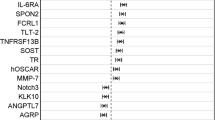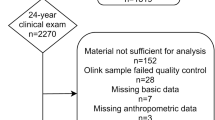Abstract
Background:
Adipokines could pose a link between adiposity, systemic inflammation and metabolic disease risk. However, it is unclear whether representative biomarkers are methodologically suitable for use in human obesity research.
Methods:
We assessed the intra-individual reproducibility of selected adipokines in a sample of 207, apparently healthy, participants with available biosample collections over a 4-month period. Concentrations of the following adipokines were measured at each sampling time point: fatty-acid binding protein-4 (FABP-4), lipocalin-2, monocyte chemoattractant protein 1 (MCP-1), procalcitonin, progranulin, vaspin and visfatin/Nampt. We calculated intraclass correlation coefficients (ICC) and examined Bland−Altman plots.
Results:
The analyses suggested an overall good to excellent biomarker reproducibility over 4 months: FABP-4: ICC=0.73 (95% confidence interval: 0.65, 0.78), lipocalin-2: 0.64 (0.55, 0.71), MCP-1: 0.85 (0.81; 0.89), procalcitonin: 0.78 (0.72, 0.83), progranulin: 0.59 (0.50, 0.68) and vaspin: 0.86 (0.82, 0.89). A good agreement of the repeated measurements was further supported by the Bland−Altman plots. No substantial differences in biomarker performance according to adiposity status could be observed. Reliability of visfatin/Nampt could not be assessed due to a high number of measurements below the lower limit of detection.
Conclusion:
Results suggest that single measurements of the evaluated adipokines could be used in population-based studies aimed to assess links between obesity, inflammation and metabolic diseases.
This is a preview of subscription content, access via your institution
Access options
Subscribe to this journal
Receive 12 print issues and online access
$259.00 per year
only $21.58 per issue
Buy this article
- Purchase on Springer Link
- Instant access to full article PDF
Prices may be subject to local taxes which are calculated during checkout

Similar content being viewed by others
References
Collaboration NCDRF, Di Cesare M, Bentham J, Stevens GA, Zhou B, Danaei G et al. Trends in adult body-mass index in 200 countries from 1975 to 2014: a pooled analysis of 1698 population-based measurement studies with 19.2 million participants. Lancet 2016; 387: 1377–1396.
Berrington de Gonzalez A, Hartge P, Cerhan JR, Flint AJ, Hannan L, MacInnis RJ et al. Body-mass index and mortality among 1.46 million white adults. N Engl J Med 2010; 363: 2211–2219.
Jung UJ, Choi MS . Obesity and its metabolic complications: the role of adipokines and the relationship between obesity, inflammation, insulin resistance, dyslipidemia and nonalcoholic fatty liver disease. Int J Mol Sci 2014; 15: 6184–6223.
Anderson PD, Mehta NN, Wolfe ML, Hinkle CC, Pruscino L, Comiskey LL et al. Innate immunity modulates adipokines in humans. J Clin Endocrinol Metab 2007; 92: 2272–2279.
Fasshauer M, Bluher M . Adipokines in health and disease. Trends Pharmacol Sci 2015; 36: 461–470.
Mancuso P . The role of adipokines in chronic inflammation. Immunotargets Ther 2016; 5: 47–56.
Viswanath V, Danda D . Inflammation, metabolism and adipokines: toward a unified theory. Int J Rheum Dis 2016; 19: 633–636.
Connelly PW, Hanley AJ . Adiponectin, adipokines, and the need for long-term human studies with comprehensive end points. Arterioscler Thromb Vasc Biol 2016; 36: 2136–2137.
Boeing H, Wahrendorf J, Becker N . EPIC-Germany–A source for studies into diet and risk of chronic diseases. European Investigation into Cancer and Nutrition. Ann Nutr Metab 1999; 43: 195–204.
Peters T, Brage S, Westgate K, Franks PW, Gradmark A, Diaz MJT et al. Validity of a short questionnaire to assess physical activity in 10 European countries. Eur J Epidemiol 2012; 27: 15–25.
Xu A, Tso AW, Cheung BM, Wang Y, Wat NM, Fong CH et al. Circulating adipocyte-fatty acid binding protein levels predict the development of the metabolic syndrome: a 5-year prospective study. Circulation 2007; 115: 1537–1543.
Hotamisligil GS, Bernlohr DA . Metabolic functions of FABPs–mechanisms and therapeutic implications. Nature Rev Endocrinol 2015; 11: 592–605.
Flo TH, Smith KD, Sato S, Rodriguez DJ, Holmes MA, Strong RK et al. Lipocalin 2 mediates an innate immune response to bacterial infection by sequestrating iron. Nature 2004; 432: 917–921.
Wu G, Li H, Zhou M, Fang Q, Bao Y, Xu A et al. Mechanism and clinical evidence of lipocalin-2 and adipocyte fatty acid-binding protein linking obesity and atherosclerosis. Diabetes Metab Res Rev 2014; 30: 447–456.
O'Connor T, Borsig L, Heikenwalder M . CCL2-CCR2 signaling in disease pathogenesis. Endocr Metab Immune Disord Drug Targets 2015; 15: 105–118.
Goossens GH . The role of adipose tissue dysfunction in the pathogenesis of obesity-related insulin resistance. Physiol Behav 2008; 94: 206–218.
Lee SA, Kallianpur A, Xiang YB, Wen W, Cai Q, Liu D et al. Intra-individual variation of plasma adipokine levels and utility of single measurement of these biomarkers in population-based studies. Cancer Epidemiol Biomarkers Prev 2007; 16: 2464–2470.
Linkov F, Gu Y, Arslan AA, Liu M, Shore RE, Velikokhatnaya L et al. Reliability of tumor markers, chemokines, and metastasis-related molecules in serum. Eur Cytokine Netw 2009; 20: 21–26.
Engelberger RP, Limacher A, Kucher N, Baumann F, Silbernagel G, Benghozi R et al. Biological variation of established and novel biomarkers for atherosclerosis: Results from a prospective, parallel-group cohort study. Clin Chim Acta 2015; 447: 16–22.
Linscheid P, Seboek D, Nylen ES, Langer I, Schlatter M, Becker KL et al. In vitro and in vivo calcitonin I gene expression in parenchymal cells: a novel product of human adipose tissue. Endocrinology 2003; 144: 5578–5584.
Abbasi A, Corpeleijn E, Postmus D, Gansevoort RT, de Jong PE, Gans RO et al. Plasma procalcitonin is associated with obesity, insulin resistance, and the metabolic syndrome. J Clin Endocrinol Metab 2010; 95: E26–E31.
Nicoletto BB, Canani LH . The role of progranulin in diabetes and kidney disease. Diabetol Metab Syndr 2015; 7: 117.
Youn BS, Kloting N, Kratzsch J, Lee N, Park JW, Song ES et al. Serum vaspin concentrations in human obesity and type 2 diabetes. Diabetes 2008; 57: 372–377.
Sommer G, Garten A, Petzold S, Beck-Sickinger AG, Bluher M, Stumvoll M et al. Visfatin/PBEF/Nampt: structure, regulation and potential function of a novel adipokine. Clin Sci 2008; 115: 13–23.
Flehmig G, Scholz M, Kloting N, Fasshauer M, Tonjes A, Stumvoll M et al. Identification of adipokine clusters related to parameters of fat mass, insulin sensitivity and inflammation. PloS One 2014; 9: e99785.
Srikanthan K, Feyh A, Visweshwar H, Shapiro JI, Sodhi K . Systematic review of metabolic syndrome biomarkers: a panel for early detection, management, and risk stratification in the West Virginian population. Int J Med Sci 2016; 13: 25–38.
Acknowledgements
We express special thanks to Katrin Sprengel and Tanja Ahrens (Department of Clinical Nutrition, DIfE) for their valuable work on biomarker measurements. We thank the Human Study Centre, DIfE for data collection and biological sample logistics. We express special thanks to Dr Manuela Bergmann for her contribution by leading the underlying processes of data generation, as well as to Silke Navia Fruth and Herbert Piechot for their valuable assistance with biosample management. Particular thanks are given to the data managers, especially Ellen Kohlsdorf. Finally, we express special thanks to all EPIC-Potsdam participants for their invaluable contribution to the study.
Author information
Authors and Affiliations
Corresponding author
Ethics declarations
Competing interests
The authors declare no conflict of interest.
Additional information
Supplementary Information accompanies this paper on International Journal of Obesity website
Supplementary information
Rights and permissions
About this article
Cite this article
Eichelmann, F., Rudovich, N., Pfeiffer, A. et al. Novel adipokines: methodological utility in human obesity research. Int J Obes 41, 976–981 (2017). https://doi.org/10.1038/ijo.2017.68
Received:
Revised:
Accepted:
Published:
Issue Date:
DOI: https://doi.org/10.1038/ijo.2017.68
This article is cited by
-
Prospective and Mendelian randomization analyses on the association of circulating fatty acid binding protein 4 (FABP-4) and risk of colorectal cancer
BMC Medicine (2023)
-
Association of Single Nucleotide Polymorphism LEP-R c.668A>G (p.Gln223Arg, rs1137101) of leptin receptor gene with endometrial cancer
BMC Cancer (2021)
-
Physical activity and adipokine levels in individuals with type 2 diabetes: A literature review and practical applications
Reviews in Endocrine and Metabolic Disorders (2021)
-
Lipocalin-2 deficiency may predispose to the progression of spontaneous age-related adiposity in mice
Scientific Reports (2020)



